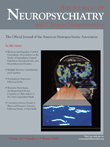Acute Pisa Syndrome and Pharnygolaryngeal Dystonia Due to Ziprasidone
To the Editor: Pisa syndrome (truncal dystonia with lateral flexion and slight rotation of the trunk) and pharyngolaryngeal dystonia are rare antipsychotic-induced dystonias. A patient developing these dystonic reactions while on ziprasidone is described.
Case Report
Mr. A, a 20-year-old Caucasian male, was admitted for exacerbation of schizoaffective disorder. He had comorbid cocaine dependence. On the day of admission (day 1), Mr. A was started on divalproex sodium, 500 mg/day, ziprasidone, 60 mg/day, and trazodone, 100 mg at bedtime. On day 2, the divalproex sodium was increased to 1000 mg/day while ziprasidone was increased to 60 mg b.i.d. with meals. Two hours after receiving the third dose of ziprasidone (before the bedtime doses of divalproex sodium and trazodone were administered), the patient developed lateral flexion of the trunk toward the right side with slight rotation. He also developed dysphonia and dysphagia. His pulse and blood pressure were 102/minute and 120/74 mmHg, respectively, and no other extrapyramidal symptoms were evident. Mr. A received benztropine, 1 mg i.m., resulting in rapid and complete resolution of the symptoms. The patient was subsequently started on oral benztropine, 1 mg b.i.d., while ziprasidone was continued at 60 mg b.i.d. along with divalproex sodium (1000 mg/day; serum level: 58 mg/ml) and trazodone (100 mg/day). There was no recurrence of dystonia on a follow-up one month later as an outpatient.
Discussion
There is only one report of Pisa syndrome with ziprasidone in the literature 1 and a PubMed search did not reveal any association of ziprasidone or other second-generation antipsychotics with pharyngolaryngeal dystonia. A similar search did not reveal any association of trazodone with Pisa syndrome and pharyngolaryngeal dystonia. Incidentally, a single case of Pisa syndrome in a patient taking valproic acid is described, but the authors were not certain whether this was due to valproic acid alone or due to a combination of valproic acid and risperidone. 2 The temporal correlation of the appearance of acute dystonia after increasing the dose of ziprasidone implicates this drug, as substantiated by other reports of acute dystonia with this drug. 3 , 4 Of interest, cocaine use has been postulated as a risk factor for acute antipsychotic-induced dystonia and this along with the young age, male gender, and rapid escalation of antipsychotic dose may have been the risk factors pertinent to this case. 5 This report underscores that pharyngolaryngeal dystonia, which has only been described with the first-generation antipsychotics, can also occur with the second-generation antipsychotics. Greater awareness of this adverse effect is desirable as the use of these drugs increases.
1 . Ziegenbein M, Schomerus G, Kropp S: Ziprasidone-induced Pisa syndrome after clozapine treatment (letter). J Neuropsychiatry Clin Neurosci 2003; 15:458–459Google Scholar
2 . Yohanan M, Aulakh JS, Weith J, et al: Pisa syndrome in a patient in a wheelchair taking valproic acid (letter). Am J Psychiatry 2006; 163:325–326Google Scholar
3 . Mason MN, Johnson CE, Piasecki M: Ziprasidone-induced acute dystonia (letter). Am J Psychiatry 2005; 162:625–626Google Scholar
4 . Weinstein SK, Adler CM, Strakowski SM: Ziprasidone-induced acute dystonic reactions in patients with bipolar disorder (letter). J Clin Psychiatry 2006; 67:327–328Google Scholar
5 . van Harten PN, Hoek HW, Kahn RS: Acute dystonia induced by drug treatment. Br Med J 1999; 319:623–626Google Scholar



